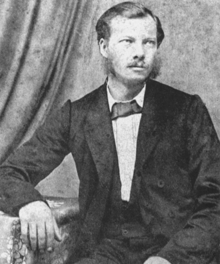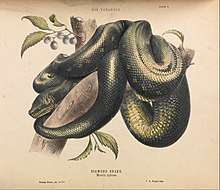Gerard Krefft
Johann Ludwig (Louis) Gerard Krefft (17 February 1830 – 19 February 1881), one of Australia's first and greatest zoologists and palaeontologists. In addition to many scientific papers, his books include The Snakes of Australia, A Catalogue of the Minerals and Rocks in the Australian Museum and A Short Guide to the Australian Fossil Remains in the Australian Museum. He published the scientific description of the Queensland Lungfish, considered a "living fossil".


Career
Krefft was born in the Duchy of Brunswick (now part of Germany) the son of William Krefft, confectioner, and his wife Johanna, née Buschhoff.[1] He was educated at St Martin's College, Brunswick,[1] and as a youth was interested in art and wished to study painting. He was, however, placed in a mercantile house and about 1850 emigrated to New York City. Krefft arrived in Australia in November 1852 and worked in the Victorian goldfields for some years. A talented artist and draughtsman, Krefft was hired to help sketch and collect specimens for the National Museum of Victoria on William Blandowski's explorations on the Murray River and Darling River in 1856–1857,[2] and in 1858 he was appointed to the National Museum to catalogue the specimens collected on the expedition.[3]
Krefft visited Germany in 1858 following the death of his father. In 1858 Krefft also showed examples of his drawings at the Victoria Industrial Society Exhibition.[4] Krefft arrived in Sydney, New South Wales in 1860 and was appointed Assistant Curator of the Australian Museum on the recommendation of Governor Sir William Denison.[1] In 1864 he was appointed Director. During his time at the Australian Museum, Krefft maintained a relationship with the Melbourne Museum, and corresponded and exchanged specimens with Frederick McCoy, the Director of that institution.[5] In 1864 he published a Catalogue of Mammalia in the Collection of the Australian Museum, and in 1865, as a pamphlet, Two Papers on the Vertebrata of the Lower Murray and Darling and on the Snakes of Sydney. These papers had been read before the Philosophical Society of New South Wales and, though the title did not show it, a third paper on the Aborigines of the Lower Murray and Darling was included in the publication.
In 1869 Krefft's The Snakes of Australia was published, which is the first definitive work on this group of Australian animals.[6] Unable to find a publisher, Krefft eventually financed the publication himself, and it was published by the Government Printer.[7] Krefft and his publication were lauded at the Sydney Intercolonial Exhibition of 1870, and Helena Scott and Harriet Scott received a Very High Commendation for the striking artwork that accompanied Krefft's text.[8] In 1871 Krefft authored The Mammals of Australia, which also included plates by the Scott sisters, Helena and Harriet. His Catalogue of the Minerals and Rocks in the Collection of the Australian Museum was published in 1873.

Krefft was fired in 1874. He was carried in his chair to the door of the Museum and thrown into the street. He had fallen foul of the Trustees, William John Macleay in particular, because he had accused them of using the museum's resources to augment private collections.[9] They responded by accusing him of drunkenness, falsifying attendance records and even allowing the sale of dirty postcards. He subsequently brought an action against one of the trustees and obtained a verdict for £250. The judge held that Krefft was a superior officer under government, and that no one had power to remove him but the governor with the advice of the executive council. Subsequently, parliament passed a vote of £1000 to be applied in satisfaction of Krefft's claims. In 1877 he began the publication of Krefft's Nature in Australia, a popular journal for the discussion of questions of natural history, but it quickly ceased publication. Krefft died on 19 February 1881 from congestion of the lungs, he was buried in the churchyard of St Jude's Church of England, Randwick. He was survived by his wife Annie, née McPhail, whom he had married on 6 February 1869, and two sons.[1]
Krefft was one of the very few supporters of Darwinism in Australia during 1870s. He became a correspondent of Charles Darwin and they exchanged supportive letters.[10]
Krefft was a member of many scientific societies, and contributed papers to the Proceedings of the Zoological Society of London and other scientific and popular journals. Some of these were printed separately as pamphlets.
Legacy
Krefft is honored in the scientific names of two reptiles endemic to Australia: Cacophis krefftii, a species of venomous snake; and Emydura macquarii krefftii, a subspecies of freshwater turtle.[11] The mountain group of Krefftberget at Barentsøya, Svalbard, is named after him.[12]
References
- Whitley, G.P.; Rutledge, Martha (1974). "Krefft, Johann Ludwig Gerard (Louis) (1830 - 1881)". Australian Dictionary of Biography, Volume 5. Melbourne: Melbourne University Press. pp. 42-44. Retrieved 5 Sep 2009
- Stephens, Matthew Sean (2013). The Australian Museum Library: its formation, function and scientific contribution, 1836-1917 (Thesis). University of New South Wales, School of Humanities.
- "Plate - Diamond snake, Morelia spilotes". Museums Victoria Collections. Museums Victoria. Retrieved 7 May 2020.
- Riley, Margot (Autumn 2016). "An Exact Observer". SL Magazine. 9 (1): 30.
- Stephens, Matthew Sean (2013). The Australian Museum Library: its formation, function and scientific contribution, 1836-1917 (Thesis). University of New South Wales, School of Humanities.
- Stephens, Matthew Sean (2013). The Australian Museum Library: its formation, function and scientific contribution, 1836-1917 (Thesis). University of New South Wales, School of Humanities.
- "Plate - Diamond snake, Morelia spilotes". Museums Victoria Collections. Museums Victoria. Retrieved 7 May 2020.
- "Plate - Diamond snake, Morelia spilotes". Museums Victoria Collections. Museums Victoria. Retrieved 7 May 2020.
- Williams D, Wüster W, Fry BG (December 2006). "The good, the bad and the ugly: Australian snake taxonomists and a history of the taxonomy of Australia's venomous snakes". Toxicon. 48 (7): 919–30. doi:10.1016/j.toxicon.2006.07.016. PMID 16999982.
- Mozley, Ann (1967). "Evolution and the Climate of Opinion in Australia, 1840-76". Victorian Studies 10 (4): 411–430.
- Beolens, Bo; Watkins, Michael; Grayson, Michael (2011). The Eponym Dictionary of Reptiles. Baltimore: Johns Hopkins University Press. xiii + 296 pp. ISBN 978-1-4214-0135-5. ("Krefft", p. 146).
- "Krefftberget (Svalbard)". Norwegian Polar Institute. Retrieved 4 April 2016.
External links
| Wikimedia Commons has media related to Gerard Krefft. |
- Works by or about Gerard Krefft at Internet Archive
- Serle, Percival (1949). "Krefft, Johann Ludwig Gerard". Dictionary of Australian Biography. Sydney: Angus and Robertson. Retrieved 5 September 2009.
- Gerard Krefft in the National Library of Australia's collection